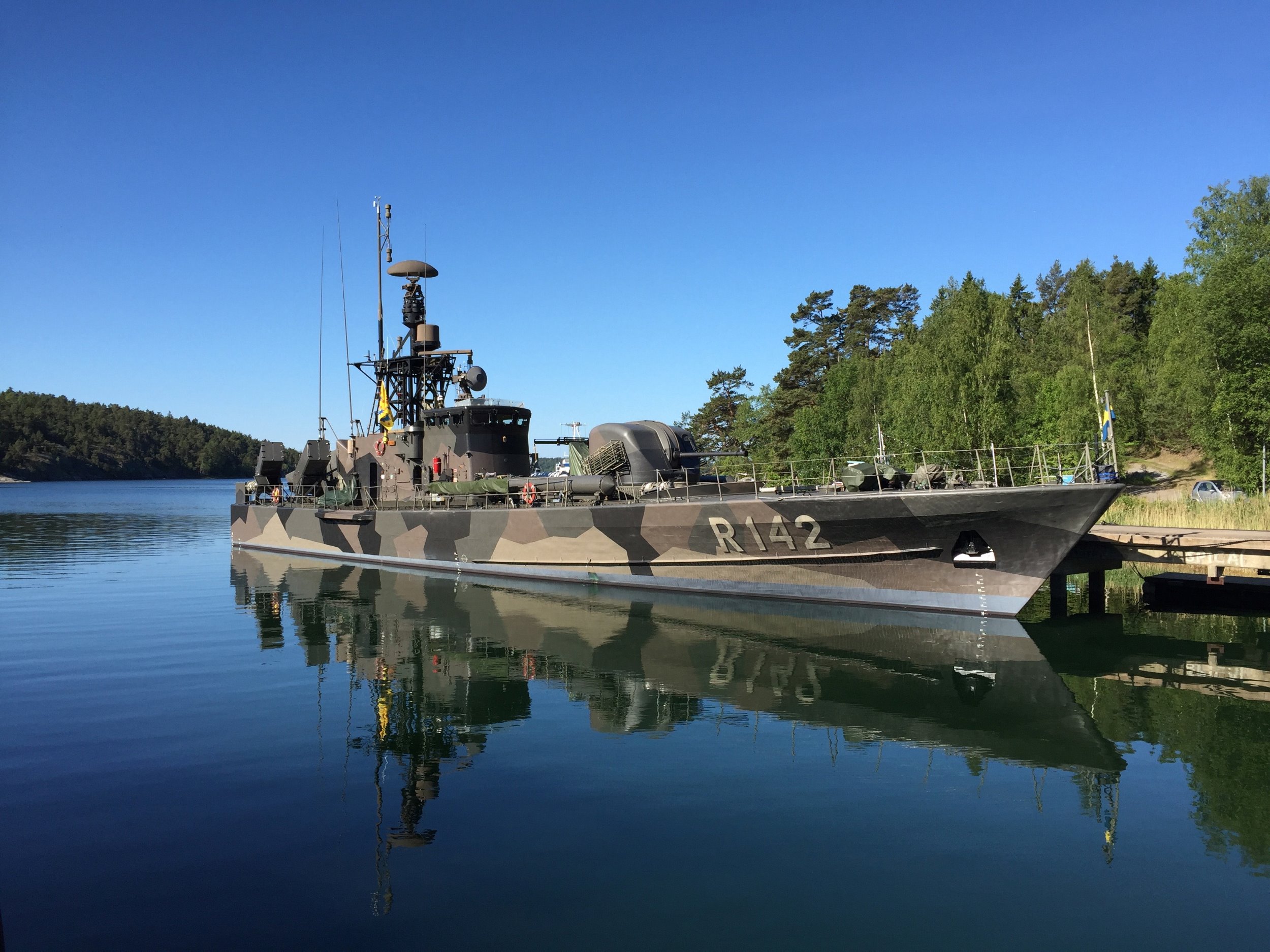



International Radio Call Sign: Sierra-Charlie-Lima-Victor
The torpedo boats of the Norrköping-class was comprised of twelve vessels which were completed at Karlskronavarvet AB 1973-76. Earlier torpedo boats were named after stars. Norrköping-class series ships were given city names. This broke a long-standing tradition in the Swedish navy of naming ships after stars and constellations, following the German example. Already in 1976, it was proposed that the Norrköping-class should be modified into Fast Attack Craft Missile (FACM) boats and the direction was that the American missile Harpoon should be purchased for the purpose. In 1979, however, the Riksdag decided that a Swedish-developed missile would be developed and procured instead of Harpoon. The result of this was that the ships were equipped with the completely Swedish-made missile RBS 15.
In 1981, modification began which included missle armament and improved radar, combat control and fire control systems. The type name is hereby changed to "Missle boat type Norrköping". In 1995, another modernization and six-year overhaul began for HMS Ystad (R-142), which was the first of six planned to be retained, the other six missile boats HMS Norrtälje (R133), HMS Varberg (R134), HMS Västerås (R135), HMS Västervik (R136), HMS Umeå (R137) and Strömstad (R141) were decommissioned.
The modernization mainly involved a number of ship-technical measures such as replacing the gas turbine 5 for electricity supply with an additional diesel-powered power plant, hydraulic start for turbines, vibration measuring equipment for main machinery, control system for torpedo weapons, missle instruments for RBS15 MK II, air conditioning in SLC, new VHF and navigation radar on the bridge as well as equipment for GMDSS and a complete rebuilding of the battle command center with MARIL 2000. The type name was changed in connection with this to "Missile boat type Ystad" and the ships with this modification would be operational until at least 2015.
First out of the modification were HMS Ystad (R 142) and HMS Norrköping (R 131), followed by HMS Nynäshamn (R132) and HMS Luleå (R139) and finally HMS Piteå (R138) and HMS Halmstad (R140). The last ships were completed in 2000.
In 2001, two more ships from the series were decommissioned, HMS Luleå (R139) and HMS Halmstad (R140), after which four ships remained.
In 2003 two more ships from the series were decommissioned, HMS Nynäshamn (R132) and HMS Piteå (R138), after which two ships remained until autumn 2005 when the two remaining missile boats in operation, HMS Ystad (R 142) and HMS Norrköping (R 131) were decommissioned while berthed at Naval base Karlskrona.
Gålö began to be used as a base for ship connections already in the 1930s. In May 1940, a torpedo plane division was based at Gålö. The base was expanded at a rapid pace and became the T2 division's permanent base with an extensive facility also on land. Along the beaches, well-protected defenses were arranged with heating devices for engines and torpedoes. In the beginning, ships were used as accommodation, but these were soon replaced by buildings on land. In January 1941, the 1st Division was forced to re-base to Karlskrona in order not to freeze inside. In April, winter had released its grip and the division was able to return to Gålö.
During 1942 – 1944, the unit was, as before, placed on a military base. An increasingly important task now became the continuous reconnaissance operations over the Baltic Sea. The Soviets expanded their submarine operations to disrupt merchant shipping between Sweden and Germany as much as possible. In connection with the convoying of this civilian shipping, the T2 division assumed great importance for surveillance. In 1944, the new torpedo and mine flotilla began to be set up at F17 Ronneby. During September of the same year, the 1st division at F2 was disbanded and Gålöbase was given other tasks.
After the Second World War, Gålö became the home of the torpedo boats. Over the years there were torpedo boats of the Plejad class in the southern harbor, later torpedo boats of the Spica class and Robot boats of the Norrköping class. Motor torpedo boats (MTB) and later patrol boats of the Hugin type were based in the northern harbor. The base operations ceased in the mid-1980s and were moved to the newly established quay facility in Berga.
The Association of Swedish Missile Boats took over the HMS Ystad from the Swedish navy in 2006 in order to preserve the ship in its original condition and keep it fully operational. The association also wants to spread knowledge about the role, for more than 30 years, of this class of ships in the Swedish armed forces. We offer companies and individuals the opportunity to support the association’s work by hiring the ship for various activities. It can be anything from a light lunch on board, while the ship is moored, to a longer trip with meals and accommodation onboard. The ship is normally based at the former RSwN torpedo base at Gålö, south of Stockholm, but is occasionally moored at the Vasa museum in Stockholm.
You can help preserve a unique part of the Swedish navy, the missile boat Ystad. At the same time you get the chance to experience the unique feeling of ”riding a fast missile boat”. Apply for membership in our association and, according to your own ability and opportunities, help keep Ystad “ship-shape” and spread knowledge about missile boats and there role in the defense of Sweden during the Cold War.


